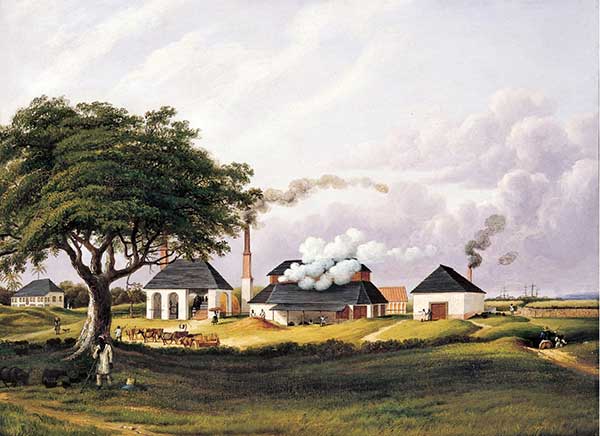In the mid-1600s, the emerald fields of Ireland and the sugar plantations of Jamaica became unlikely neighbors in history. The story begins in 1655, when the English seized Jamaica from Spain and immediately faced a labor shortage. To fill the void, they shipped in indentured workers—among them many Irish men, women, and children, uprooted by war, famine, or forced displacement.
The arrival of the Irish in Jamaica didn’t happen by chance. Back in Ireland, the mid-17th century was a time of upheaval: Cromwell’s campaigns, confiscation of lands, persecution of Catholics, and the dispossession of many Irish families. As resistance was crushed, many were forcibly removed, sold, or sent overseas to serve long contracts under indenture in colonial plantations.

By 1655, as the English took more control in the Caribbean, they sent hundreds—perhaps thousands—of Irish workers to Jamaica to “populate the colony” and meet the demand for labor. Many were children (aged 10–14) and orphans, or convicts, or dispossessed Catholics with little choice. Life in Jamaica was brutal. The tropical heat, diseases, malnutrition, and hard labor claimed many lives. The Irish newcomers often found themselves working alongside African slaves, in terrible conditions. Some English observers even remarked that Irish indentured laborers were derided as “white slaves” when forced into the harshest tasks.
Yet unlike enslaved Africans, many Irish workers had a fixed term of service. Once their indentures expired, some gained freedom, purchased land, or entered the militia. Over time, additional Irish came voluntarily—some seeking new opportunities, some following the path where indentures had ended.

Seeds of Culture: Irish Roots in Jamaican Soil
Even as the physical presence of Irish immigrants dwindled over centuries, their influence became woven into Jamaica’s social, linguistic, and cultural tapestry.
Language & Speech
One vivid legacy is speech. Irish settlers—especially those assigned to teach English to African slaves—brought their Hiberno-English inflections, idioms, and rhythms. Over time, Jamaican Patois absorbed some of these elements. The lilt, cadence, and certain turns of phrase echo the fusion of Irish and West African linguistic traditions.
Place Names & Settlement Markers

Across the island lie echoes of Irish place names and heritage. Names like Irish Town and Dublin Castle nod to early Irish settlements. The first free village established post-emancipation—Sligoville—was named after the Marquess of Sligo, who had strong ties to Ireland.
Food & Drink
“Irish Moss,” a creamy Jamaican beverage made from seaweed (often Gracilaria species), sugar, milk, spices like nutmeg and cinnamon, and sometimes peanuts, is said to reflect a cross-cultural borrowing. Some traditions trace its “Irish” name to the seaweed introduced by early Irish in Jamaica. 
Customs, Dance & Identity
Beyond words and place names, Irish influence appears in unexpected cultural forms. Some dance and folkloric traditions, such as Maroon Morris, combine Irish and Scottish steps with Afro-Jamaican rhythms, creating a hybrid heritage of movement.
Irish surnames—Ryan, Daly, O’Connor, O’Hara—though Anglicized, appear among Jamaica’s population.
Irish influence is also visible in Jamaica’s religious and educational institutions: many priests and nuns of Irish descent taught in Jamaican schools over centuries, helping transmit European cultural forms while also influencing local traditions.
Fractured Histories, Enduring Legacies
The relationship between Ireland and Jamaica is neither romantic nor simple. It is fraught with oppression, displacement, assimilation, loss, and survival.
The forced transportation of the Irish by English authorities represented one colonial oppression layered atop another. Though many Irish workers were not enslaved in the same legal structure as Africans, the brutality of their conditions was real.
And over time, the identities of many Irish-descended Jamaicans blended into the broader African-Jamaican majority—making heritage subtle, hidden, or forgotten.
Yet scholars in recent decades have rediscovered these threads. Works such as The Irish in Jamaica during the long eighteenth century explore the ties between Irish families, plantation ownership, and social networks. Documentary projects and cultural exchange initiatives have highlighted how Jamaican culture retains echoes of Ireland—especially in music, folklore, and language.
A Story Woven Across Oceans
Imagine a child in 17th-century Ireland, orphaned by war, pushed into indenture, shipped across the Atlantic to Jamaica. That child toils under a tropical sun, speaks a broken mix of Gaelic, English, and no language at all. Over time, that child blends into a new society, marries, carries memory in language and lineage, yet is absorbed into another identity.
Over centuries, the line of Irish descent becomes faint—but in certain ways it is still there: in the rise and fall of surnames, in speech cadences that seem to dance between islands, in recipes and leaves named after faraway shores, in the footwork of dancers who step to music that blends West African beats and Celtic echoes.
Now, in Jamaica, a vast majority trace ancestry to Africa. But among those roots, hidden in the branches, lie strands of Ireland. The story of Irish Jamaica is not just a tale of brutality or diaspora—it is a story of cultural fusion, adaptation, and whispered legacies that resist total erasure.





